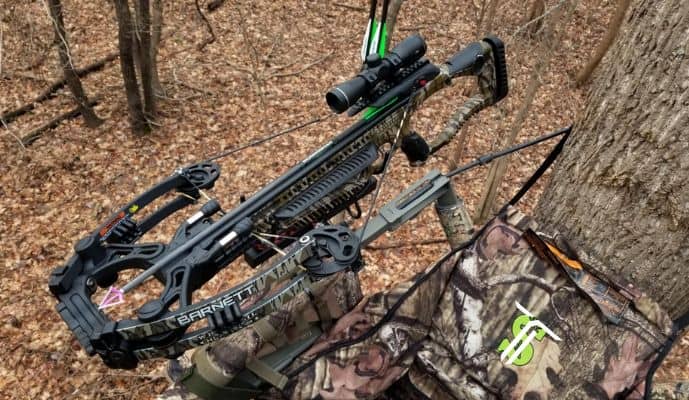How To String a Crossbow (Simple Tutorial)
String a bow could be a difficult task, especially for beginners. One should know the accurate instructions; otherwise, one could get hurt. Moreover, you can string a crossbow with or without using a stringer.

How To String a Crossbow
There are two methods for stringing a crossbow; let’s talk about them.
How to String a Crossbow by Hand
More arm strength is used in this method. Your body weight and force depend directly while applying this method. This method cannot be applied on a compound bow as it has a pulley at the end.
1. Hook Crossbow String onto one Nock
As the heading suggests, the hook on the end of the string to the nock on one end, the other nock should remain empty, and one hook should stay spare. Make sure that the hook you have tied to the nock is properly fitted to the nock.
2. Angle a Crossbow on a Hard Surface
Put the side of a bow down on the floor so that the nock, hooked by the string, remains on the floor side, and the other empty nock is tilted up towards your hand with which you work primarily. This blank nock side should be tilted. Get the unhooked string in your dominant hand now.
Use your non-dominant or secondary hand to steady the back of the barrel, also called a butt. The unhooked string in your primary hand will help in this operation later. Remember that the hard floor is adequate while stringing the crossbow at home. Outside doing this task, it is better to use a wooden block.
If a wooden block is unavailable at that time, you may use your shoes in a way that puts the prod over the shoe; make sure beneath it is the sole side. If you get a wooden block, then create a hole in the middle and put the hooked side of the prod (bow) in it. This would make your stringing task easier.
3. Apply Pressure to the Bow Using Your Foot
Put your foot on the prod part of the weapon. Lean towards the prod so that pressure is maximized. Try to put pressure barefoot so that no accident may occur. Try keeping your foot at the center of the prod to keep the balance. If your crossbow has a stirrup, don’t ever put pressure on it because this could wreck the stirrup creating damage, and you can also hurt yourself.
4. Pull-up on the Barrel of the Crossbow
Use your dominant hand and take it towards the barrel of the crossbow. Grab the barrel and pull it towards your body. Keep on applying pressure with your foot. By doing this, you would see the prod bending. Your secondary hand should be pulling up the other end of the prod.
5. Nock The Other End Of The String
Free the crossbow barrel and use your dominant hand to hook up the other end of the prod with a strong. Join the loop of the string to the free nock.
Examine Your Work
Now check the steps you made to tie the string. Pick the crossbow upward and examine both nocks. If the strings attached to the nocks are loose, it could be dangerous while firing from a crossbow.
6. String Removal Process
The Removal removal process is done in the same way but in reverse. Place the crossbow on the floor as before. Apply the same pressure while hooking up the strings with the nock. Tilt the barrel so that one hook comes up toward your side. Unhook the nock. Now bring the crossbow up and unhook the other nock.
How to string a crossbow using a stringer?
The best thing about this method is it can be used with any crossbow, regardless of any draw weight and strength you apply. Using a stringer is easier and safer than the first method in which no stringer is used.
1. Bowstring Attachment
Place the crossbow on the ground or any sufficient surface while applying his procedure. Take the bowstring and attach its one loop to the nock of the bow.
2. Attach Stringer at Both Sides
Hook one end of the stringer on the hooked nock directly over the bowstring. Move the stringer towards yourself so it stretches, and then hook its other end with the nock on the other side, which is empty.
Make sure that the bowstring is sorter than both the stringer and the bow span because that is the main reason the bowstring cannot be attached by itself without using pressure. Talking about the sizes, however, the length of the bow span and bow stringer should be almost the same.
3. Hooking-Up Stringer In a Latch
Make the crossbow in a position where the barrel points up. Now take the bow stringer, pull it back with pressure, and hook it up in the latch of the crossbow. If you have an option of a stirrup in the bow, then put your foot in it so that you can apply force easily in pulling up the bowstring and hook it up.
Keep in mind that the stringer is weak and consumes less force when you attach it to the latch. This makes it easy for the bow to bend, and you can easily attach the bowstring to the nocks.
4. It’s Time to Hook the other End
Pick the loose end of the actual string and hook the other nock with it. Just recheck that the bowstring’s loop is beneath the stringer’s loop. It is a time-consuming process, but make sure you do this as it is important.
5. Give it a Try
Now fire the empty crossbow in this manner; the stringer will fall off, and the actual bowstrings will remain attached to the crossbow.
6. The Remaining End of Stringer
To remove the stringer from the other nock, you must be careful because the actual string and the stringer may be tangled together. You may use a flat screw or any other tool to untangle both.
Check Your Work
Check your work whether both the strings are attached accurately to both nock or not.
7. Unhook the strings
To unhook the strings, reverse the whole process carefully.
Conclusion
Using a stringer is more accessible than by hand; however, it highly depends on yourself which way you like, and feels easy to follow up. Just recheck your steps, whatever method you use to string your bow. It would be dangerous for you and others if you mishandled the procedure.
